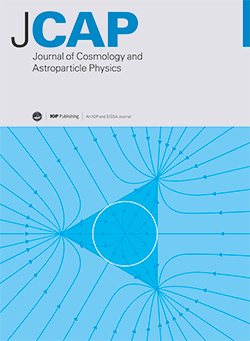Reconstructing primordial curvature perturbations via scalar-induced gravitational waves with LISA
IF 5.3
2区 物理与天体物理
Q1 ASTRONOMY & ASTROPHYSICS
Journal of Cosmology and Astroparticle Physics
Pub Date : 2025-05-22
DOI:10.1088/1475-7516/2025/05/062
引用次数: 0
Abstract
Many early universe scenarios predict an enhancement of scalar perturbations at scales currently unconstrained by cosmological probes. These perturbations source gravitational waves (GWs) at second order in perturbation theory, leading to a scalar-induced gravitational wave (SIGW) background. The LISA detector, sensitive to mHz GWs, will be able to constrain curvature perturbations in a new window corresponding to scales k ∈ [1010, 1014] Mpc-1, difficult to probe otherwise. In this work, we forecast the capabilities of LISA to constrain the source of SIGWs using different approaches: i) agnostic, where the spectrum of curvature perturbations is binned in frequency space; ii) template-based, modeling the curvature power spectrum based on motivated classes of models; iii) ab initio, starting from first-principles model of inflation featuring an ultra-slow roll phase. We compare the strengths and weaknesses of each approach. We also discuss the impact on the SIGW spectrum of non-standard thermal histories affecting the kernels of SIGW emission and non-Gaussianity in the statistics of the curvature perturbations. Finally, we propose simple tests to assess whether the signal is compatible with the SIGW hypothesis. The pipeline used is built into the SIGWAY code.利用LISA利用标量引力波重建原始曲率扰动
许多早期宇宙场景预测,在目前不受宇宙探测器约束的尺度上,标量扰动会增强。在微扰理论中,这些扰动源是二阶引力波,导致了标量诱导引力波背景。LISA探测器对兆赫兆兆兆瓦非常敏感,它将能够在一个新的窗口中约束曲率扰动,该窗口对应于尺度k∈[1010,1014]Mpc-1,否则很难探测到。在这项工作中,我们预测了LISA使用不同方法约束sigw来源的能力:i)不可知论,其中曲率扰动的频谱在频率空间中被分割;Ii)基于模板的曲率功率谱建模,基于模型的激励类;Iii)从头开始,从具有超慢滚动阶段的通货膨胀第一原理模型开始。我们比较了每种方法的优缺点。我们还讨论了影响SIGW发射核的非标准热历史对SIGW谱的影响以及曲率摄动统计中的非高斯性。最后,我们提出了简单的测试来评估信号是否符合SIGW假设。所使用的管道内置于SIGWAY代码中。
本文章由计算机程序翻译,如有差异,请以英文原文为准。
求助全文
约1分钟内获得全文
求助全文
来源期刊

Journal of Cosmology and Astroparticle Physics
地学天文-天文与天体物理
CiteScore
10.20
自引率
23.40%
发文量
632
审稿时长
1 months
期刊介绍:
Journal of Cosmology and Astroparticle Physics (JCAP) encompasses theoretical, observational and experimental areas as well as computation and simulation. The journal covers the latest developments in the theory of all fundamental interactions and their cosmological implications (e.g. M-theory and cosmology, brane cosmology). JCAP''s coverage also includes topics such as formation, dynamics and clustering of galaxies, pre-galactic star formation, x-ray astronomy, radio astronomy, gravitational lensing, active galactic nuclei, intergalactic and interstellar matter.
 求助内容:
求助内容: 应助结果提醒方式:
应助结果提醒方式:


